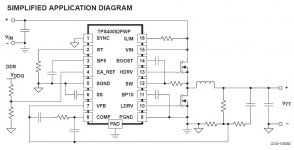doesn't it seem to you that the two are quite similar? they all have a pwm comparator, driven some sort of switches. a half-bridge based step down converter looks almost identical to a typical post-filter Class D amp.
The difference, of course, is that a DC converter may not be fast enough to respond to an audio signal but isn't it worth tryint to find out?
Here is a TI chip, TPS50052, a step-down converter good to 40v. it has a pwm comparator, and build-in gate drivers.
all you need to do is to redesign the filter, and inject the input signal to the Vfb node, with a resistor to control gain.
alternatively, you can use one of those pwm controller chips to generate a pwm signal and use that to drive switches.
Has anyone tried it yet? would it work in real life?
The difference, of course, is that a DC converter may not be fast enough to respond to an audio signal but isn't it worth tryint to find out?
Here is a TI chip, TPS50052, a step-down converter good to 40v. it has a pwm comparator, and build-in gate drivers.
all you need to do is to redesign the filter, and inject the input signal to the Vfb node, with a resistor to control gain.
alternatively, you can use one of those pwm controller chips to generate a pwm signal and use that to drive switches.
Has anyone tried it yet? would it work in real life?
Attachments
It might be workable, but I believe that most of the better class-D designs are either based on sigma-delta data converter architectures or are self-oscillating, not fixed frequency PWM based.
- Status
- Not open for further replies.
